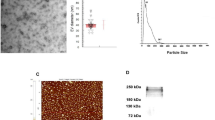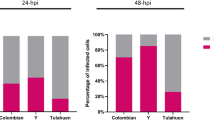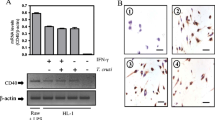Abstract
The haemoflagellate Trypanosoma cruzi is the causative agent of Chagas’ disease that occurs in approximately 8 million people in Latin America. Patients infected with T. cruzi frequently suffer of cardiomegaly and may die of myocardial failure. Here we show that T. cruzi trypomastigotes (extracellular form) increased in vitro apoptosis of rat cardiomyocytes. Additionally, we demonstrated that amastigotes (intracellular form), for which a method for purification was established, were also able to induce cardiomyocyte apoptosis. Increase of apoptosis was associated with up-regulation of the apoptotic gene bax by trypomastigotes, while expression of the anti-apoptotic gene bcl-2 was down-regulated by amastigotes. The transcription factor STAT3 but not STAT1 was activated in cardiomyocytes by trypomastigotes. In addition, tlr7 gene expression was up-regulated in cardiomyocytes incubated with trypomastigotes, suggesting that this Toll-like receptor is involved in the intracellular recognition after host cell invasion by T. cruzi. Glycosylphosphatidylinositols purified from trypomastigotes did not induce cardiomyocyte apoptosis and STAT activation but down-regulated tlr7 gene expression. In conclusion, cardiomyopathy observed in Chagas’ disease might be in part due to apoptosis of cardiomyocytes induced directly by the parasite.




Similar content being viewed by others
References
Rossi MA, Bestetti RB (1995) The challenge of chagasic cardiomyopathy. The pathologic roles of autonomic abnormalities, autoimmune mechanisms and microvascular changes, and therapeutic implications. Cardiology 86:1–7
Parada H, Carrasco HA, Anez N, Fuenmayor C, Inglessis I (1997) Cardiac involvement is a constant finding in acute Chagas’ disease: a clinical, parasitological and histopathological study. Int J Cardiol 60:49–54
Rassi A Jr, Rassi A, Little WC (2000) Chagas’ heart disease. Clin Cardiol 23:883–889
Higuchi Mde L, Benvenuti LA, Martins Reis M, Metzger M (2003) Pathophysiology of the heart in Chagas’ disease: current status and new developments. Cardiovasc Res 60:96–107
Palomino SA, Aiello VD, Higuchi ML (2000) Systematic mapping of hearts from chronic chagasic patients: the association between the occurrence of histopathological lesions and Trypanosoma cruzi antigens. Ann Trop Med Parasitol 94:571–579
Tostes S Jr, Bertulucci Rocha-Rodrigues D, de Araujo Pereira G, Rodrigues V Jr (2005) Myocardiocyte apoptosis in heart failure in chronic Chagas’ disease. Int J Cardiol 99:233–237
de Souza EM, Araujo-Jorge TC, Bailly C, Lansiaux A, Batista MM, Oliveira GM, Soeiro MN (2003) Host and parasite apoptosis following Trypanosoma cruzi infection in in vitro and in vivo models. Cell Tissue Res 314:223–235
Aoki MP, Guinazu NL, Pellegrini AV, Gotoh T, Masih DT, Gea S (2004) Cruzipain, a major Trypanosoma cruzi antigen, promotes arginase-2 expression and survival of neonatal mouse cardiomyocytes. Am J Physiol Cell Physiol 286:C206–C212
Ley V, Andrews NW, Robbins ES, Nussenzweig V (1988) Amastigotes of Trypanosoma cruzi sustain an infective cycle in mammalian cells. J Exp Med 168:649–659
Barry SP, Townsend PA, Latchman DS, Stephanou A (2007) Role of the JAK-STAT pathway in myocardial injury. Trends Mol Med 13:82–89
Campos MA, Closel M, Valente EP, Cardoso JE, Akira S, Alvarez-Leite JI, Ropert C, Gazzinelli RT (2004) Impaired production of proinflammatory cytokines and host resistance to acute infection with Trypanosoma cruzi in mice lacking functional myeloid differentiation factor 88. J Immunol 172:1711–1718
Oliveira AC, Peixoto JR, de Arruda LB, Campos MA, Gazzinelli RT, Golenbock DT, Akira S, Previato JO, Mendonca-Previato L, Nobrega A, Bellio M (2004) Expression of functional TLR4 confers proinflammatory responsiveness to Trypanosoma cruzi glycoinositolphospholipids and higher resistance to infection with T. cruzi. J Immunol 173:5688–5696
Bafica A, Santiago HC, Goldszmid R, Ropert C, Gazzinelli RT, Sher A (2006) Cutting edge: TLR9 and TLR2 signaling together account for MyD88-dependent control of parasitemia in Trypanosoma cruzi infection. J Immunol 177:3515–3519
Caetano BC, Carmo BB, Melo MB, Cerny A, dos Santos SL, Bartholomeu DC, Golenbock DT, Gazzinelli RT (2011) Requirement of UNC93B1 reveals a critical role for TLR7 in host resistance to primary infection with Trypanosoma cruzi. J Immunol 187:1903–1911
Ruppert V, Meyer T, Pankuweit S, Moller E, Funck RC, Grimm W, Maisch B (2008) Gene expression profiling from endomyocardial biopsy tissue allows distinction between subentities of dilated cardiomyopathy. J Thorac Cardiovasc Surg 136(360–369):e361
Heidecker B, Kittleson MM, Kasper EK, Wittstein IS, Champion HC, Russell SD, Hruban RH, Rodriguez ER, Baughman KL, Hare JM (2011) Transcriptomic biomarkers for the accurate diagnosis of myocarditis. Circulation 123:1174–1184
Debierre-Grockiego F, Schwarz RT (2010) Immunological reactions in response to apicomplexan glycosylphosphatidylinositols. Glycobiology 20:801–811
Wennicke K, Debierre-Grockiego F, Wichmann D, Brattig NW, Pankuweit S, Maisch B, Schwarz RT, Ruppert V (2008) Glycosylphosphatidylinositol-induced cardiac myocyte death might contribute to the fatal outcome of Plasmodium falciparum malaria. Apoptosis 13:857–866
Roggero E, Perez AR, Tamae-Kakazu M, Piazzon I, Nepomnaschy I, Besedovsky HO, Bottasso OA, del Rey A (2006) Endogenous glucocorticoids cause thymus atrophy but are protective during acute Trypanosoma cruzi infection. J Endocrinol 190:495–503
Chen QM, Alexander D, Sun H, Xie L, Lin Y, Terrand J, Morrissy S, Purdom S (2005) Corticosteroids inhibit cell death induced by doxorubicin in cardiomyocytes: induction of antiapoptosis, antioxidant, and detoxification genes. Mol Pharmacol 67:1861–1873
Zhang J, Andrade ZA, Yu ZX, Andrade SG, Takeda K, Sadirgursky M, Ferrans VJ (1999) Apoptosis in a canine model of acute chagasic myocarditis. J Mol Cell Cardiol 31:581–596
Henriques-Pons A, Oliveira GM, Paiva MM, Correa AF, Batista MM, Bisaggio RC, Liu CC, Cotta-De-Almeida V, Coutinho CM, Persechini PM, Araujo-Jorge TC (2002) Evidence for a perforin-mediated mechanism controlling cardiac inflammation in Trypanosoma cruzi infection. Int J Exp Pathol 83:67–79
Petersen CA, Krumholz KA, Carmen J, Sinai AP, Burleigh BA (2006) Trypanosoma cruzi infection and nuclear factor kappa B activation prevent apoptosis in cardiac cells. Infect Immun 74:1580–1587
Tarleton RL, Zhang L (1999) Chagas disease etiology: autoimmunity or parasite persistence? Parasitol Today 15:94–99
Bambino-Medeiros R, Oliveira FO, Calvet CM, Vicente D, Toma L, Krieger MA, Meirelles MN, Pereira MC (2012) Involvement of host cell heparan sulfate proteoglycan in Trypanosoma cruzi amastigote attachment and invasion. Parasitology 138:593–601
Ferreira ER, Bonfim-Melo A, Mortara RA, Bahia D (2012) Trypanosoma cruzi extracellular amastigotes and host cell signaling: more pieces to the puzzle. Front Immunol 3:363
Manque PA, Probst CM, Pereira MC, Rampazzo RC, Ozaki LS, Pavoni DP, Silva Neto DT, Carvalho MR, Xu P, Serrano MG, Alves JM, Meirelles Mde N, Goldenberg S, Krieger MA, Buck GA (2011) Trypanosoma cruzi infection induces a global host cell response in cardiomyocytes. Infect Immun 79:1855–1862
Wang S, Kotamraju S, Konorev E, Kalivendi S, Joseph J, Kalyanaraman B (2002) Activation of nuclear factor-kappaB during doxorubicin-induced apoptosis in endothelial cells and myocytes is pro-apoptotic: the role of hydrogen peroxide. Biochem J 367:729–740
Liu J, Mao W, Ding B, Liang CS (2008) ERKs/p53 signal transduction pathway is involved in doxorubicin-induced apoptosis in H9c2 cells and cardiomyocytes. Am J Physiol Heart Circ Physiol 295:H1956–H1965
Fujio Y, Kunisada K, Hirota H, Yamauchi-Takihara K, Kishimoto T (1997) Signals through gp130 upregulate bcl-x gene expression via STAT1-binding cis-element in cardiac myocytes. J Clin Invest 99:2898–2905
Harada M, Qin Y, Takano H, Minamino T, Zou Y, Toko H, Ohtsuka M, Matsuura K, Sano M, Nishi J, Iwanaga K, Akazawa H, Kunieda T, Zhu W, Hasegawa H, Kunisada K, Nagai T, Nakaya H, Yamauchi-Takihara K, Komuro I (2005) G-CSF prevents cardiac remodeling after myocardial infarction by activating the Jak-Stat pathway in cardiomyocytes. Nat Med 11:305–311
Ponce NE, Cano RC, Carrera-Silva EA, Lima AP, Gea S, Aoki MP (2012) Toll-like receptor-2 and interleukin-6 mediate cardiomyocyte protection from apoptosis during Trypanosoma cruzi murine infection. Med Microbiol Immunol 201:145–155
Ouaissi A, Guilvard E, Delneste Y, Caron G, Magistrelli G, Herbault N, Thieblemont N, Jeannin P (2002) The Trypanosoma cruzi Tc52-released protein induces human dendritic cell maturation, signals via Toll-like receptor 2, and confers protection against lethal infection. J Immunol 168:6366–6374
Campos MA, Almeida IC, Takeuchi O, Akira S, Valente EP, Procopio DO, Travassos LR, Smith JA, Golenbock DT, Gazzinelli RT (2001) Activation of Toll-like receptor-2 by glycosylphosphatidylinositol anchors from a protozoan parasite. J Immunol 167:416–423
Acknowledgments
This work was supported by the Deutsche Stiftung für Herzforschung (to F.D.-G., R.T.S., and B.M.), Alumni Medizin Marburg e.V. (to P.S.), Roland und Elfriede Schauer-Stiftung (to P.S.), Studienstiftung des Deutschen Volkes (to P.S.), BMBF BRA 07/046 (to R.T.S. and M.A.C.), NIH 1RO1AI071319-01 (to R.T.G.), INCTV/CNPq 573547/2008-4/FAPEMIG CBB—APQ-00077-09 (to R.T.G. and M.A.C.), FAPEMIG CBB—APQ-01603-09 (to M.A.C.), and the program PROBRAL of DAAD/CAPES (to R.T.S. and R.T.G.).
Author information
Authors and Affiliations
Corresponding author
Additional information
Philipp Stahl and Volker Ruppert contributed equally to this work. A part of this work is presented as a partial fulfilment of the requirements of the doctoral thesis (Dr. rer. nat.) of Philipp Stahl.
Rights and permissions
About this article
Cite this article
Stahl, P., Ruppert, V., Meyer, T. et al. Trypomastigotes and amastigotes of Trypanosoma cruzi induce apoptosis and STAT3 activation in cardiomyocytes in vitro. Apoptosis 18, 653–663 (2013). https://doi.org/10.1007/s10495-013-0822-x
Published:
Issue Date:
DOI: https://doi.org/10.1007/s10495-013-0822-x




